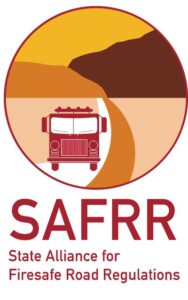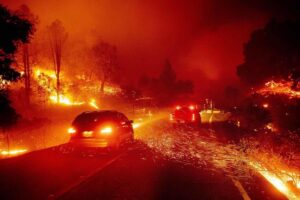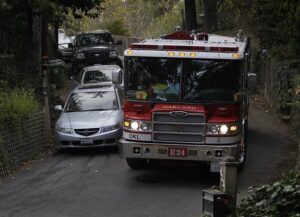Climate-intensified wildfires are a fact of life in our region and throughout California. More intense and frequent wildfires result in devastating loss of life and property – horrific wind-driven fires are jumping freeways and burning residences both within forests and far from the “Wildland Urban Interface.”
SAFRR commends the State Board of Forestry and Fire Protection’s (BOF) 2022 decision to uphold road standards that are protective of life by adopting and expanding statewide Minimum Fire Safe Road Regulations, despite opposition from development interests.
The intent of fire safe road standards is to provide for access by large firefighting equipment with simultaneous evacuation of residents and workers.
Fire safe road regulations save both citizen and firefighters’ lives by requiring access to new developments in high fire risk zones be via existing and new roadway and bridge infrastructure that meets standards for safe evacuation.
Key statewide standards for new residential and commercial developments in areas where CAL FIRE leads the fire response (State Responsibility Area or SRA) and for Very High Fire Hazard Severity Zones in cities (Local Responsibility Area or LRA) require both existing and new access roads: be minimum 20 feet wide, able to meet bridge weight limit requirements, and have two ways out (maximum length of dead-end roads, depending on size of project, only up to 1 mile).
SAFRR prevailed in protecting long-standing fire safe road standards, and we continue to monitor legislation and rulemaking at the State level. In early 2023, SAFRR and our ally, a retired CAL FIRE official, met with Department of Natural Resource and CAL FIRE officials to improve training, oversight and enforcement of local jurisdictions implementation of the fire safe road standards.
Local decision-makers continue to undermine the State Fire Safe Regulations, both via local non-compliant land use decisions, no enforcement and due to the influence of the Rural County Representatives of California – a lobbying group comprised of 39 counties representing 60 % of California’s lands, yet fewer than 14 % of the population.
Thus, in 2023, SAFRR continues its participation in local proceedings, objecting to applications for projects that violate the fire safe road standards. We are working with fire professionals to draw CAL FIRE and the Natural Resources Agency’s attention to the violations and have asked the state to take action to address violations.
Napa and Sonoma County Supervisors ignore State requirements for adequate road access as well as CEQA’s wildfire and public safety provisions.
- In 2020, the BOF rejected Sonoma’s ordinance seeking to exempt all roads developed prior to 1991. Now, Napa’s Supervisors are supporting an exemption-based Ordinance.
- Sonoma County’s Supervisors continue to approve large commercial cannabis operations in fragile watersheds along one-lane, dead-end roads in areas most at risk for wildfire – such as Los Alamos Road.
- Despite a road network that cannot support safe evacuation, in December, 2022 Sonoma County approved a plan for a city-scale development at the rural Sonoma Development Center – a decision that is being litigated.
LEARN MORE ABOUT SAFRR’S SIGNIFICANT ON-GOING WORK – THEN DONATE!
Heed Experts’ Warnings: Go to SAFRRs ABOUT pages, and read concerns about the risks to life and property, filed by wildfire professionals, California legislators, the California Attorney General and Insurance Commissioner, if the regulations are not enforced. Experts warn that emergency evacuation situations are a time of chaos; thus, rapid evacuations depend on fire safe roads.
Sonoma County Conservation Council (SCCC) presented SAFRR with its Environmentalists of the Year award. SAFRR’s 2022 WIN presentation explains our 4-pronged strategy to protect public safety:
1) Conduct Robust Analyses;
2) Use Extensive Networking to Develop and Leverage Allies;
3) Communicate-Communicate and re-Communicate; and
4) Fundraise and Prepare, well in advance, to launch a Legal Action.
SAFRR also prepared a Lessons Learned presentation to support environmental and public safety advocates with tips on how to navigate convoluted regulatory and legal processes.
PLEASE MAKE A DONATION TODAY:
To protect lives, we must ensure project approvals require adequate access roads that provide for safe concurrent ingress and egress.
DONATE TO SAFRR – NorCal
DONATE TO SAFRR – SoCal
Contributions to our 501(c)(3) fiscal partner, Sonoma County Tomorrow
Tax ID #: 94-3019165 are tax deductible to the extent allowed by law.


